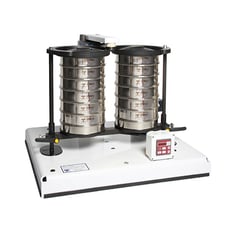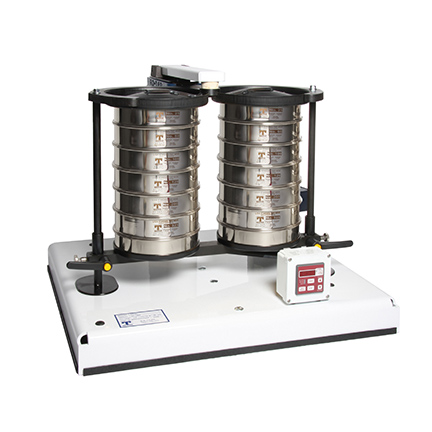What Is a RO-TAP® RX-94 Sieve Shaker? (Definition, Function, and Cost)
Test sieve analysis is considered one of the oldest, most reliable particle analysis techniques practiced today. While hand sieving was initially used to conduct test sieve analysis, sieve shakers were created to speed up the process and reduce user error, ultimately increasing the accuracy and repeatability of results gathered.
But as there are dozens of sieve shakers, such as the W.S. Tyler RO-TAP® RX-94, on the market, it can sometimes be hard to identify which one is right for you. That said, what exactly is a RO-TAP RX-94?
W.S. Tyler has been a leading manufacturer of particle analysis equipment for over 140 years and is here to help you pinpoint which sieve shaker will deliver the best possible results based on your specific needs.
To help, this article will cover:
- What a RO-TAP RX-94 is
- How the RO-TAP RX-94 works
- What Sieves can be used with the RO-TAP RX-94
- How to set up the RO-TAP RX-94
- The typical maintenance you should expect
- How much the RO-TAP RX-94 costs
What Is a RO-TAP RX-94 Sieve Shaker?

The W.S. Tyler RO-TAP RX-94 is a mechanical sieve shaker designed to work with two stacks of test sieves. Having said that, this device facilities particle movement in both stacks using a single hammer, like the RO-TAP RX-29.
How Does the RO-TAP RX-94 Work?
The RO-TAP RX-94 has a similar operation to an RX-29. It uses oscillating movements and tapping motions to promote particle movement throughout the stack of sieves.
You can expect the RX-94 to perform 278 oscillations per minute and 150 taps per minute. These are the exact RX-29 specifications that dozens of industry standards reflect.
The RX-94 also features a similar digital timer as other RO-TAP models that allows lab technicians to accurately test material for up to 99 minutes.
To that end, it has been discovered that it is beneficial to run another end of sieve analysis when switching from a single stack mechanical sieve shaker, such as the RX-29, to the RX-94. This is mainly because the hammer of the machine is the same size and weight as the RX-29; however, the force is being distributed between two sieves.
This is especially true when working with material 200 mesh and finer.
What Sieves Can I Use With the RO-TAP RX-94?
The RX-94 is designed to run two stacks of 8-inch or 200mm test sieve simultaneously. When using full-height sieves, a stack can consist of six sieves with a pan, whereas when using half-height sieves, a stack can consist of 13 sieves with a half-height pan.
That said, your sieve stacks must be the same height when conducting a test sieve analysis. This is because the cover that helps keep that sieves in pace and transfer the energy from the tapping action of the sieve is one solid piece.
What Initial Setup Is Required?
Much like the other RO-TAP devices, initial setup is easy. Simply plug the device into an appropriate power outlet, place your sieves on the device, fasten the sieves using the included lid, and set the timer.
The RX-94 should be placed on either a sturdy table or on the floor. A sound enclosure kit specially designed for the RO-TAP RX-94 can be purchased to not only minimize sound but, more importantly, to maximize the safety of lab technicians.
What Maintenance Is Typically Required?
The RO-TAP RX-94 does rely on several brass parts to function correctly, much like other RO-TAP devices. Depending on usage, you will want to keep an eye on the eccentric disc, the bushings, and any other brass parts.
You will want to keep the rods that allow the sieve stack height to be adjusted clean and free of any damaging debris. This is especially true when you typically use fewer sieves.
Lastly, you will want to keep a close eye on the cork that rests on top of the sieve cover. This is because the cork is constantly being beaten up by the hammer and sees the most wear.
To ensure your RX-94 continues to perform as it should, you should always inspect all aspects of your machine, from the hammer to the timing belt, regularly.
How Much Does the RO-TAP RX-94 Cost?
The RO-TAP RX-94 is just over $5,462.73. The price of the overall order, however, will vary based on if you need test sieves or wish to pair it with a sound enclosure (part number: RX99).
That said, the sound enclosure for the RX-94 is approximately $1,604.51.
Additionally, as sieves are not included with the purchase of a RO-TAP device, the cost of any sieves you may need can also contribute to an increased price expectation.
Implement the Right Equipment To Achieve Accurate and Repeatable Results
The RX-94 is a mechanical sieve shaker that allows lab technicians to run two stacks of test sieves simultaneously. It is ideal for those running multiple tests on a single RX-29 device daily or those with multiple RX-29 devices in their lab and looking to condense their lab setup.
But for your process to yield dependable results, you must incorporate the right equipment. Having the right equipment helps to facilitate each step of the test sieve analysis process easily and accurately.
As prominent particle size analysis leaders with over 140 years of experience, W.S. Tyler aims to help its customers identify and implement the particle analysis equipment suitable for their needs.
Read the following article to learn more about what a reliable test sieve analysis setup looks like:
About Ronnie Brown
Ronnie is the Content Writer for W.S. Tyler and has four years of experience as a professional writer. He strives to expand his knowledge on all things particle analysis and woven wire mesh to leverage his exceptional writing and graphic design skills, creating a one-of-a-kind experience for customers.





